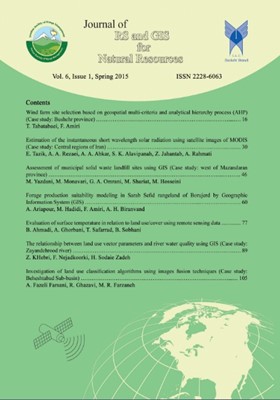The relationship between land use vector parameters and river water quality using GIS (Case study: Zayandehrood river)
Subject Areas : Geospatial systems developmentZahra Khebri 1 , Farhad Nejadkoorki 2 , Hamid Sodaie Zadeh 3
1 - MSc. Student of Environment, Yazd University, Yazd, Iran
2 - Assoc. Prof. Department of Environment, Yazd University, Yazd, Iran
3 - Assis. Prof. Department of Arid Land and Desert Management, Yazd University, Yazd, Iran
Keywords:
Abstract :
The Rivers are more important sources of surface water and fresh water in urban, agricultural and industrial. The aim of this study is to evaluate effects of pollutant sources on the water quality of river Zayandehroud using Geographic information systems (GIS). In this study, physicochemical data (Discharge, Hardness, Cl, EC, pH), (October 2010 to May 2011) were studied in 7 stations of Zayandehroud. A land use map of the surrounding environment was then investigated with a buffer 0f 10 km from center of the river. Considering the location of monitoring stations the key factors, distance to industrial unit and land use percentage within the station buffet were calculated using GIS. Data moves to SPSS®19 for further statistical analysis. The results show that, at 451682.3 hectares of around buffer the river consisted; 40.9% agricultural and 8.1% urban development. We also found that the physicochemical parameters have a direct with the increase agricultural area around each station relationship. Also located industries in the area of Polkalleh to Chum stations such as south Isfahan refinery, have a significant relationship with water quality factors discussed in this study. So considering the protection importance of the Zayandehroud river, applying appropriate management on this river is essential, especially in the areas after the city. Implementation of appropriate treatment system for industrial wastewater, advised to farmers in the proper use of chemical fertilizers can be the appropriate solution.


